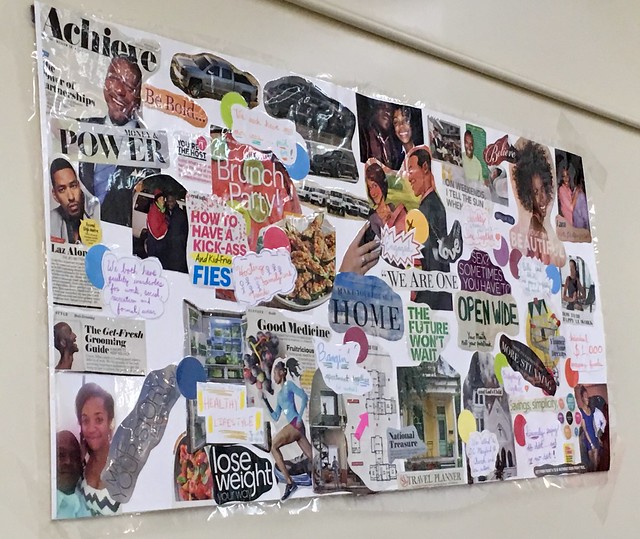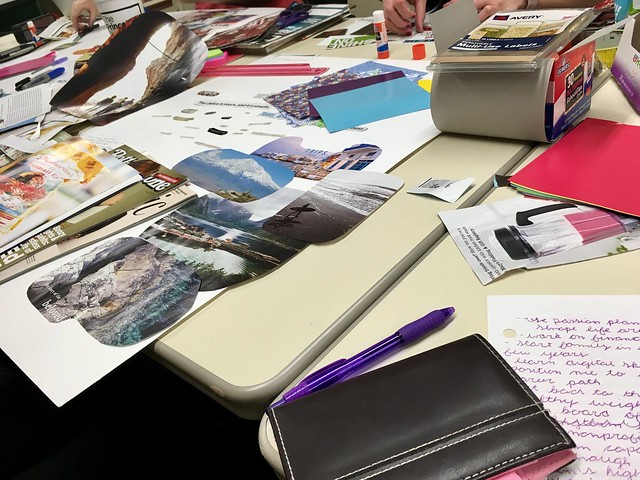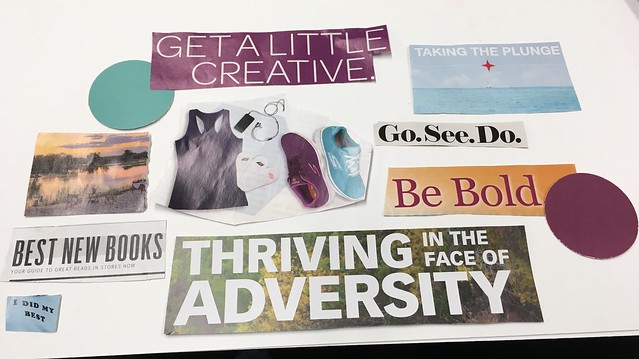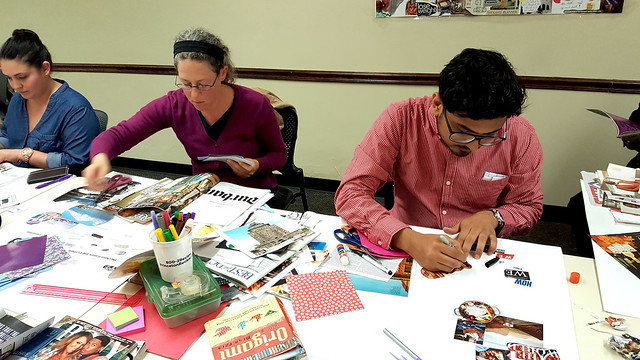Class Report
20/20 — Bringing Your Vision to Life
Visualization is a simple but powerful tool that can help you realize your potential. Ever wonder about the science behind it? In our Bringing Your Vision to Life class participants gained insight into this very topic and created their own vision boards.
Taylor Davis, a self-proclaimed ‘craftster’ who strongly believes in the combined power of daily positive affirmation and visualization, first led the class through an explanation of why visualization works and how it can help you achieve your goals. The class isn’t called 20/20 for nothing- students were creating a ‘clear vision’ for their own lives.
Davis emphasized the importance of visualizing your future by thinking about where you want to be in the next five, 10, and 15 years. Vision boards are the pictorial representation of this brainstorm to remind yourself of your goals daily.

Taylor brought her own vision board to show the class how it’s done.
But how does it work? Davis broke the science down into two categories: the Law of Attraction and powerful visualization. The Law of Attraction states that what you put into the universe, you’ll get back - therefore, by creating a vision board (what you put in), you’ll have a greater chance of succeeding. As for vision boards as a powerful visualization tool, having a constant reminder of what you are working for is proven to help initiate action toward the goal.
Davis also described the importance to a positive mindset to attaining your goals. She shared the acronym FADAF, meaning Failure And Difficulty Are Feedback, to remind participants to take feedback and criticism positively. She encouraged participants to beat the negative and focus on the positive on the road to achieving goals.
A vision board does not equal a magical manifestation of your goals – it takes action. Part of the visualization process is picturing and planning the steps it takes to achieve your goals.

Our workstations were filled with magazines, colorful paper and pencils, origami cutouts, glue, and cardboard paper.
After the explanation, the majority of the class was spent doing, not teaching. Davis led the students through a goals-generating exercise where they had time to write down short-term and long-term goals they’ve set for themselves and even identify new ones.
Davis advised everyone to dream big, but realistic, during the goal exercise. A few of the goal setting areas she suggested were focused on career, health, relationships, wealth, and overall life.
Participants were then given free rein to leaf through magazines, newspapers, and other items to find what spoke to them and reflect on their goals for their own personalized vision boards. The room was quickly filled with sounds of cutting, pasting, and flipping, while inspiring music played in the background.

Here are a few of the items I selected for starting my own vision board.
Once everyone was done, the results were pretty amazing!
The students left with more knowledge than when they arrived on why visualization is a key tool for achieving your goals and how to put it into practice–not to mention a great start on a future vision board.

The group’s inspiring vision boards!
Taylor provided a few additional takeaways in the follow-up email:
- Hang your vision boards in a HIGHLY visible space
- Spend time daily reminding yourself of your goals, envisioning the completion of each goal, and reflecting on your progress in moving towards each goal. Try to do this EVERY day.
- Your goals are within reach. Decide today to achieve them!


Melinda Tolliver is one of the newest members of KCDC’s communications volunteer team. She loves the thrill of stringing together powerful, eloquent messages in under 140 characters, and creating thoughtful visuals to go with them. For her full-time gig, she executes digital communications at a higher education–minded association. Follow her tweets and grams with @mmptolliver.
